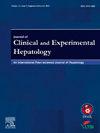肝移植受者的排斥反应
IF 3.3
Q2 GASTROENTEROLOGY & HEPATOLOGY
Journal of Clinical and Experimental Hepatology
Pub Date : 2024-02-22
DOI:10.1016/j.jceh.2024.101363
引用次数: 0
摘要
尽管随着免疫抑制管理的进步,肝移植后排斥反应的发生率有所下降,但排斥反应仍然影响着移植受者。排斥反应的诊断仍具有挑战性,肝活检仍是诊断的参考标准。对排斥反应类型和严重程度进行正确分类是非常必要的,因为这可以指导管理并最终保护移植物。未来有希望的领域包括检测排斥反应的非侵入性检测,以降低侵入性检测带来的发病率,以及免疫抑制管理的进一步发展,以减少免疫抑制带来的毒性,同时最大限度地降低与排斥反应相关的发病率。本文章由计算机程序翻译,如有差异,请以英文原文为准。
Rejection in Liver Transplantation Recipients
Rejection following liver transplantation continues to impact transplant recipients although rates have decreased over time with advances in immunosuppression management. The diagnosis of rejection remains challenging with liver biopsy remaining the reference standard for diagnosis. Proper classification of rejection type and severity is imperative as this guides management and ultimately graft preservation. Future areas of promise include non-invasive testing for detection of rejection to reduce the morbidity associated with invasive testing and further advances in immunosuppression management to reduce toxicities associated with immunosuppression while minimizing rejection related morbidity.
求助全文
通过发布文献求助,成功后即可免费获取论文全文。
去求助
来源期刊

Journal of Clinical and Experimental Hepatology
GASTROENTEROLOGY & HEPATOLOGY-
CiteScore
4.90
自引率
16.70%
发文量
537
审稿时长
64 days
 求助内容:
求助内容: 应助结果提醒方式:
应助结果提醒方式:


